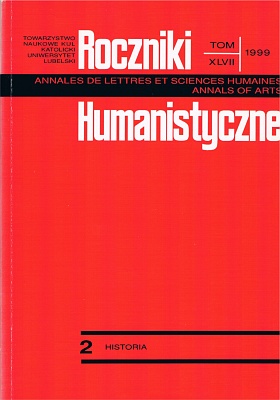Dzieci porzucone w rodzinach zastępczych w Rzymie i okolicach w XVII i XVIII wieku
Abstrakt
The phenomenon of abandoning unwanted babies that had been known and occurred on a large scale for ages was also extremely frequent in the area of the whole Church State. A special role in rescuing such babies and in helping them throughout their lives was played by the Holy Spirit Hospital in Rome that was founded by Pope Innocent III and run by the Order of the Holy Spirit. The model and system of fostering abandoned children was used for many ages by other charity organizations, run not only by that order.
The building of the Rome hospital was planned in such a way that it guaranteed complete anonymousness to the people exposing their babies and keeping the matter in secret. The babies, who were usually brought at night or at dusk, were put into a drum mounted into the outer wall. After turning the drum, at the bell's signal, the waifs were transferred to the person on duty inside the hospital and then to the wet nurses constantly residing in the hospital. In the 17th and 18th centuries nearly 1000 babies on average were brought to the hospital every year.
The phenomenon of abandoning babies was so common that the Holy Spirit Hospital was not able to secure lodgings and care or maintainance for them. Hence efforts were made to give as many foundlings as possible to women living outside the hospital to be fed and fostered. In return for this the wet nurses received regular help in money and clothes from the hospital. Women willing to act as wet nurses had to meet strict conditions laid down by the hospital. The conditions concerned their health and quality of their milk as well as their moral-ethical attitude, religious life and financial status. Because of the better weather as well as moral conditions such wet nurses were preferred who came from small villages situated mainly within several dozen kilometres from Rome.
The number of children who were with their foster parents in the 18th century was about 2000. An absolute majority of waifs (over 90%) given to foster parents in small towns and villages found themselves in peasant families, whereas most families that took care of the hospital children in Rome were craftsmen's families.
Abandoned babies were often used by their foster parents in an illegal way to get money. Such a behaviour of the wet nurses and their families was a large scale phenomenon throughout the 18th century. Keeping the babies' death secret in order to continue receiving help from the hospital was quite frequent. Also abandoning babies by legally married couples and taking them back from the hospital for profit reached frightening proportions. So called intermediaries' actions had the most criminal character. They were involved in trading the foundlings. The inspectors often found more than a dozen waifs illegally taken from the hospital in their homes, that also served as hiding places.
Copyright (c) 1999 Roczniki Humanistyczne

Utwór dostępny jest na licencji Creative Commons Uznanie autorstwa – Użycie niekomercyjne – Bez utworów zależnych 4.0 Międzynarodowe.





